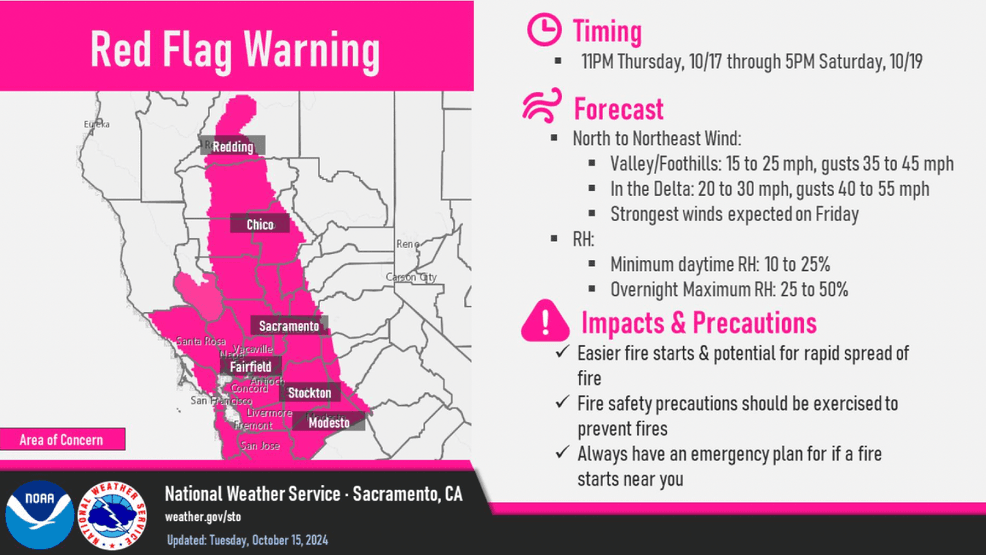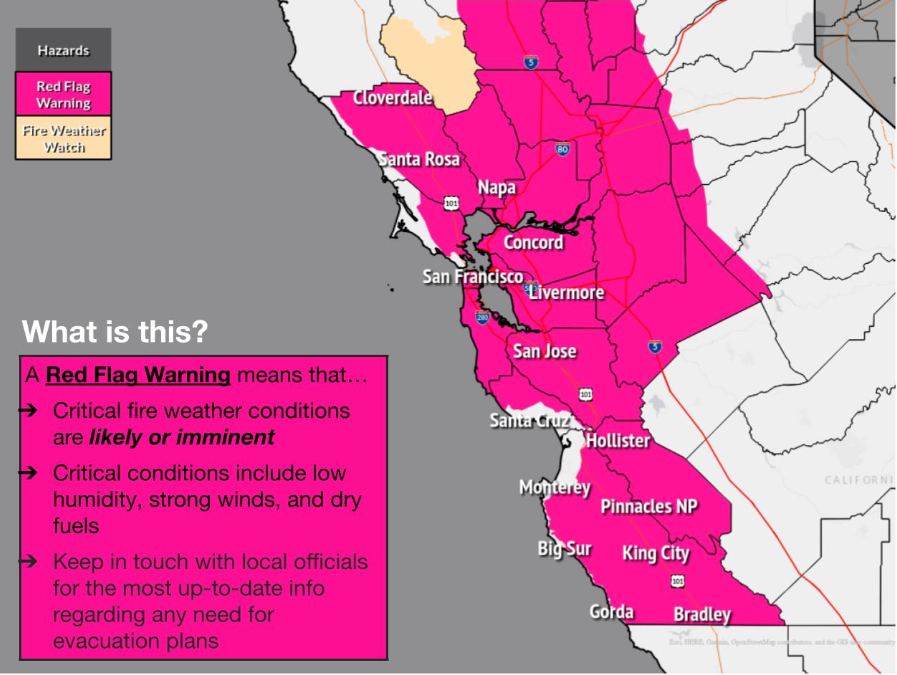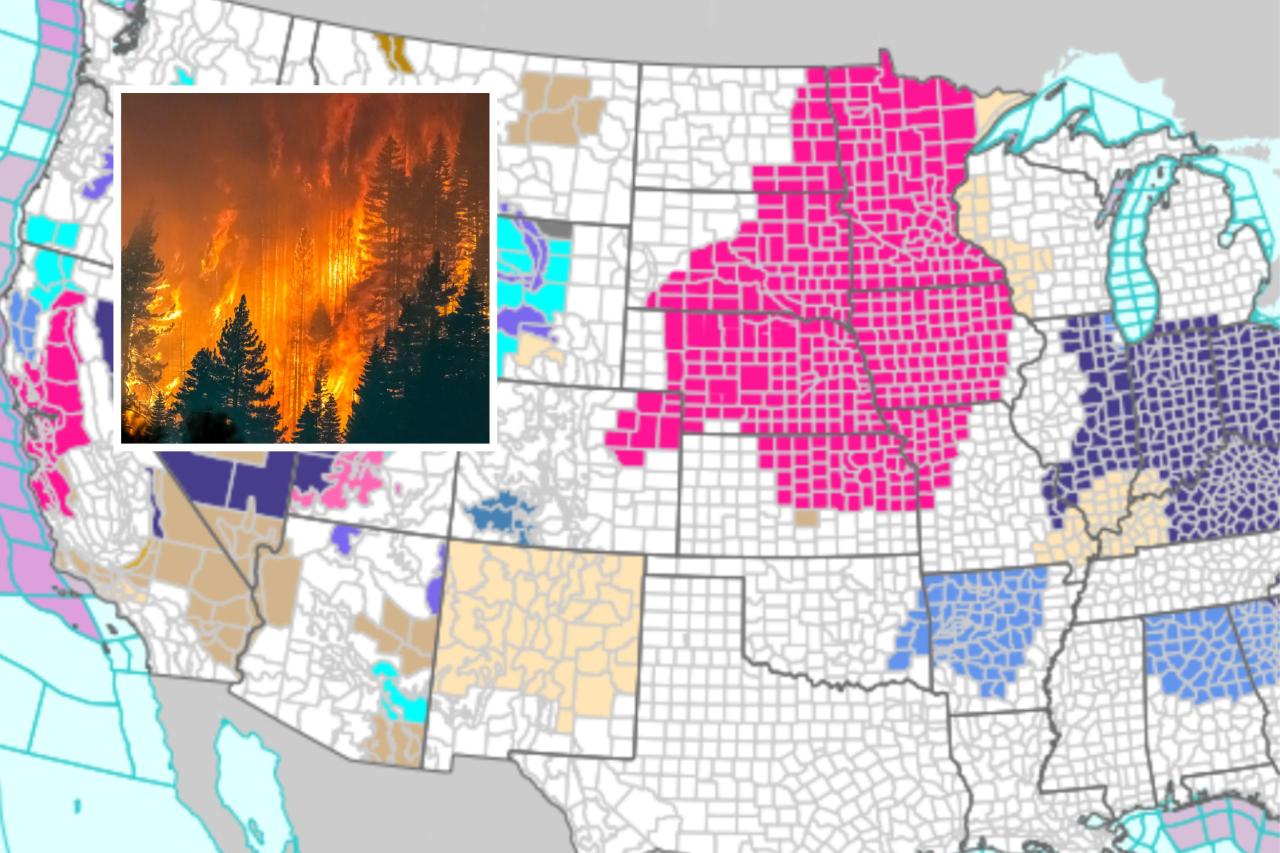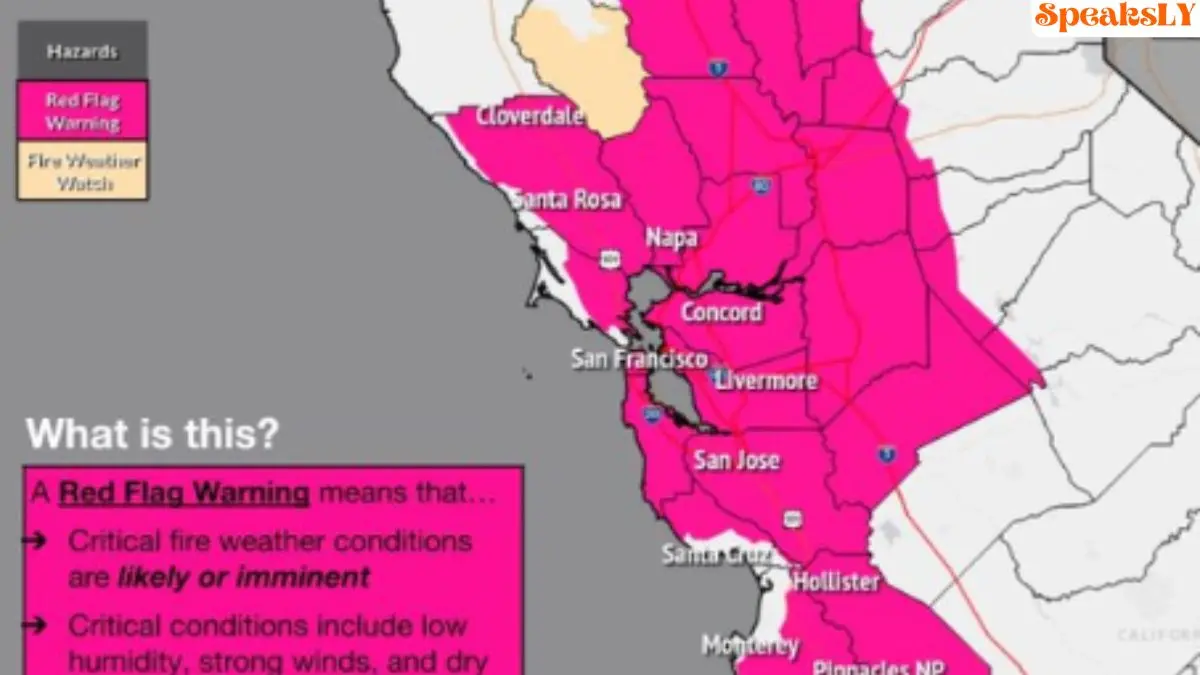When a red flag fire weather warning is issued, it’s time to take immediate action. These warnings indicate a dangerous combination of weather conditions that can lead to explosive wildfire growth, threatening lives, property, and ecosystems.
Understanding the causes, impacts, and proper responses to red flag fire weather warnings is crucial for staying safe during these high-risk periods.
Definition and Explanation
A red flag fire weather warning is issued when weather conditions are favorable for the rapid spread of wildfires. These conditions include low humidity, high temperatures, and strong winds.
Red flag fire weather warnings are typically issued when the following conditions are met:
- Relative humidity is less than 25%.
- Temperatures are above 90 degrees Fahrenheit.
- Wind speeds are sustained at or above 25 miles per hour.
Impacts and Consequences: Red Flag Fire Weather Warning
Red flag fire weather warnings signal an elevated risk of wildfires, posing severe threats to communities, ecosystems, and infrastructure. These wildfires can cause widespread devastation, leading to loss of life, property damage, and ecological disruptions.
When the red flag fire weather warning is issued, it’s time to be extra vigilant. The extreme conditions create a perfect storm for wildfires, so it’s important to take precautions to protect your home and family. But even in the midst of such a dangerous situation, there’s always room for a little bit of beauty.
Just like the way Beabadoobee’s heartfelt anthem, Pictures of Us , can provide a moment of solace and reflection, even in the darkest of times. And as the fire danger subsides, we can all take a moment to appreciate the resilience of our communities and the beauty that can be found even in the most challenging of circumstances.
Historically, red flag fire weather warnings have been associated with some of the most catastrophic wildfires on record. For instance, the Black Saturday bushfires in Australia in 2009, fueled by extreme fire weather conditions, resulted in the tragic loss of 173 lives and the destruction of over 2,000 homes.
Community Impacts, Red flag fire weather warning
- Loss of life and injuries: Wildfires can spread rapidly, trapping and injuring residents. The intense heat and smoke can cause severe burns, respiratory problems, and even death.
- Property damage and infrastructure loss: Wildfires can destroy homes, businesses, and other structures. They can also damage power lines, roads, and other essential infrastructure, disrupting daily life and economic activities.
- Displacement and evacuation: Residents may need to evacuate their homes and communities to escape the advancing flames. This can lead to temporary displacement, disruption of daily routines, and emotional distress.
Ecological Impacts
- Habitat destruction: Wildfires can destroy vast areas of vegetation, including forests, grasslands, and wetlands. This can disrupt ecosystems, reduce biodiversity, and impact wildlife populations.
- Air and water pollution: Wildfires release large amounts of smoke and other pollutants into the air and water. This can degrade air and water quality, posing health risks to humans and wildlife.
- Soil erosion and nutrient loss: Wildfires can burn away vegetation that helps hold soil in place, leading to erosion and loss of soil nutrients. This can impact soil fertility and ecosystem health.
Preparedness and Response
Red flag fire weather warnings indicate extreme fire danger, requiring immediate action from individuals and communities. Being prepared for these warnings is crucial for mitigating the risk of wildfires and protecting lives and property.
Individuals and communities can take several actions to prepare for and respond to red flag fire weather warnings:
Evacuation Plans
- Develop and practice evacuation plans for homes, businesses, and schools.
- Identify multiple evacuation routes and designated meeting places.
- Prepare an emergency kit with essential supplies, including water, non-perishable food, first-aid supplies, and important documents.
Fire Safety Measures
- Clear brush and other flammable materials away from homes and buildings.
- Create defensible space around structures by removing dead vegetation and trimming trees.
- Have a fire extinguisher and smoke detectors installed and regularly maintained.
Community Preparedness
- Establish community fire watch programs to monitor for signs of fire and report suspicious activity.
- Coordinate with local fire departments and emergency responders to ensure efficient response.
- Educate the community about fire prevention and preparedness measures.
Response to Warnings
- Monitor weather forecasts and heed red flag fire weather warnings.
- Follow evacuation orders immediately and evacuate to designated safe areas.
- Avoid outdoor activities and remain indoors with windows and doors closed.
Meteorological Factors
Red flag fire weather conditions are characterized by a combination of meteorological factors that create a heightened risk of wildfires. These factors include:
• Temperature: High temperatures, typically above 90°F (32°C), contribute to the drying out of vegetation, making it more flammable.
• Humidity: Low humidity, below 30%, causes vegetation to become even drier and more susceptible to burning.
• Wind speed: Strong winds, sustained at 15 mph (24 km/h) or gusting to 25 mph (40 km/h), can fan flames and spread wildfires rapidly.
• Precipitation: A lack of precipitation, especially during extended dry spells, further exacerbates drought conditions and increases the risk of wildfires.
Fire Behavior and Spread
Red flag fire weather conditions create an environment conducive to extreme fire behavior and rapid spread. These conditions increase the likelihood of wildfires becoming uncontrollable and causing significant damage.
When relative humidity is low, fuels become drier and more flammable. High temperatures and strong winds further exacerbate the situation, providing the necessary energy and oxygen to sustain and intensify the fire. Additionally, dry and windy conditions promote the formation of fire whirls and embers, which can spread the fire over long distances.
Red flag fire weather warnings are issued when weather conditions are ripe for a rapid spread of wildfires. With dry fuels, strong winds, and low humidity, the risk of a wildfire escalating quickly is heightened. To stay informed about potential wildfire threats, visit reputable sources like the Beabadoobee Website: A Gateway to the Musical World , which provides up-to-date information on fire weather conditions and evacuation routes.
By staying vigilant and informed, you can take necessary precautions to protect yourself and your community from the devastating effects of wildfires.
Rapid Fire Growth
- Low fuel moisture: Dry fuels ignite easily and burn intensely, releasing more heat and embers, leading to rapid fire growth.
- Strong winds: Winds fan the flames, increasing the rate of combustion and spreading embers to new areas, creating spot fires and extending the fire’s perimeter.
- Unstable atmosphere: Atmospheric instability promotes updrafts and downdrafts, creating erratic wind patterns that can cause sudden changes in fire direction and intensity.
- Topography: Steep slopes and canyons can channel winds, intensifying the fire’s spread and making it difficult to contain.
- Fuel type: Highly flammable vegetation, such as dry grasses and shrubs, can contribute to rapid fire spread, especially in open areas.
Communication and Outreach
Effective communication and outreach are crucial during red flag fire weather warnings to convey the risks and prepare the public for potential wildfires. Timely and accurate information empowers individuals and communities to take appropriate actions to protect lives and property.
Outreach efforts should focus on raising awareness, educating the public about fire safety measures, and providing clear instructions on what to do in the event of a wildfire.
The red flag fire weather warning signifies extreme fire conditions, posing a grave threat to life and property. As we strive to enhance our preparedness, it’s crucial to foster literacy in our communities. Literasi , an Indonesian literacy organization, plays a vital role in educating citizens about fire safety measures and empowering them to make informed decisions during these perilous times.
By bridging the gap between knowledge and action, we can mitigate the risks associated with red flag fire weather warnings and protect our communities from the devastating consequences of wildfires.
Disseminating Information
- Utilize multiple communication channels such as social media, news outlets, and emergency alert systems to disseminate warnings and updates.
- Collaborate with local authorities, fire departments, and community organizations to distribute information through various platforms.
- Establish a dedicated website or hotline for the public to access real-time updates and resources.
Public Education
- Educate the public about the risks associated with red flag fire weather conditions, including the potential for rapid fire spread and extreme fire behavior.
- Promote fire safety practices such as clearing brush and debris around homes, creating defensible space, and having an evacuation plan in place.
- Conduct community outreach programs and workshops to provide hands-on training and resources.
Evacuation Preparedness
- Provide clear instructions on evacuation routes and designated safe zones.
- Encourage the public to have an evacuation kit ready with essential supplies, including food, water, medications, and important documents.
- Coordinate with local authorities to establish evacuation centers and provide support to evacuees.
Technology and Monitoring
Monitoring and predicting red flag fire weather conditions involve the use of various technologies. These technologies contribute significantly to early detection and warning systems, enabling timely and effective response to potential fire threats.
Remote Sensing
Remote sensing technologies, such as satellites and weather radars, provide valuable data on atmospheric conditions, vegetation health, and fuel moisture levels. Satellite imagery can detect smoke plumes, monitor fire spread, and identify areas at risk. Weather radars track precipitation, wind patterns, and lightning activity, which are crucial factors in fire behavior prediction.
Numerical Weather Prediction (NWP) Models
NWP models are computer simulations that forecast weather conditions based on mathematical equations and real-time data. These models incorporate observations from weather stations, satellites, and other sources to generate detailed predictions of temperature, humidity, wind speed, and precipitation. NWP models are used to identify areas where red flag fire weather conditions are likely to occur.
Fire Danger Rating Systems
Fire danger rating systems combine meteorological data with information on fuel conditions to assess the potential for fire ignition and spread. These systems assign a numerical value or category to indicate the level of fire danger. Fire danger ratings are used by fire management agencies to issue warnings and advisories to the public.
Wildfire Detection Systems
Wildfire detection systems use a combination of sensors and cameras to monitor for the presence of smoke or flames. These systems can be deployed in remote areas or on mountaintops to provide early detection of wildfires. Automated detection algorithms can quickly identify and alert authorities to potential fires, enabling a rapid response.
Case Studies and Lessons Learned
Understanding the effectiveness of red flag fire weather warnings requires examining past responses and learning from their outcomes. Case studies provide valuable insights into both successful and unsuccessful responses, highlighting key factors that influence preparedness and response efforts.
Successful Responses
- 2003 Canberra Bushfires: Timely warnings and effective coordination among emergency services allowed for successful evacuations and resource deployment, minimizing casualties.
- 2009 Black Saturday Bushfires: Enhanced warning systems and community education programs played a crucial role in increasing public awareness and promoting early action.
Unsuccessful Responses
- 1991 Oakland Hills Firestorm: Inadequate warnings and communication failures contributed to delayed evacuations and a high death toll.
- 2018 Camp Fire: A combination of extreme fire weather, poor warning dissemination, and evacuation challenges resulted in widespread destruction and loss of life.
Lessons Learned
These case studies underscore the importance of:
- Accurate and timely warnings
- Effective communication and public education
- Interagency coordination and resource sharing
- Community preparedness and evacuation plans
- Post-event evaluations and improvements
By incorporating these lessons into future preparedness efforts, communities can enhance their resilience to red flag fire weather and reduce the risks associated with these extreme events.
Closing Notes
Preparing for and responding effectively to red flag fire weather warnings requires a collective effort from individuals, communities, and emergency responders. By staying informed, taking proactive steps, and following safety guidelines, we can mitigate the risks and protect ourselves from the devastating impacts of wildfires.



